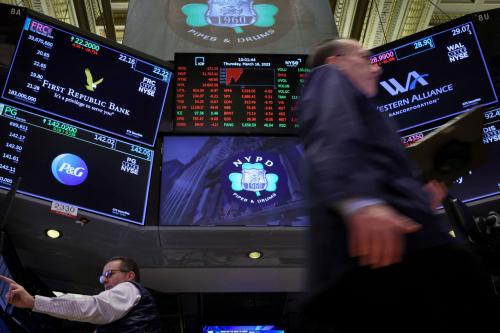For anybody who spends time in Brussels, one of the more baffling mysteries in the self-styled “capital of Europe” is the lack of communication between the North Atlantic Treaty Organization and the European Union. Even though these vital Western institutions are located just a few miles from each other, there is a striking absence of policy coordination between them. This, at a time when the European continent is confronting multiple crises whose solutions will require ingenuity, innovative thinking, and smarter use of resources.
Happier together
The need for closer collaboration between the EU and NATO makes sense for several reasons. There is now greater overlap in membership than ever before—22 out of 28 NATO countries also belong to the EU. European allies are worried about an American retreat and want to see a reinvigorated U.S. commitment to their security. In fortifying ties between the two organizations, Europe could be reassured by an abiding American involvement on their continent. And deeper bonds between NATO and the EU could have tangible political benefits, perhaps even to help persuade Britain to stay in the EU.
For the United States, this kind of initiative could revitalize the transatlantic alliance as the foundation of our political, security, and economic relations with the rest of the world. It could also demonstrate that the community of Western democracies still remains our front line in defending common values and interests in the 21st century.
A new approach to Western security cooperation—starting by creating a joint policy planning council linking the EU and NATO—should extend beyond military thinking and pursue more imaginative responses to current threats. Those include hybrid warfare by Russia, surging waves of refugees from North Africa and the Middle East, pandemic disease, climate change, and economic instability on Europe’s periphery.
Future security challenges will demand more pluralistic policy responses that could be best accomplished by combining NATO and EU assets and capabilities. In the fight against terrorism, NATO could work directly with the EU to connect national criminal databases and use the EU’s special powers to seize financial assets of suspected criminals.
The EU and NATO should also collaborate to avoid conflict with Russia over the control of energy resources and shipping lanes through the Arctic region. The melting polar icecap will transform global shipping routes by shaving thousands of nautical miles and up to seven days of travel time off current itineraries through the Suez and Panama canals. For those reasons alone, it is imperative for the West to prevent Russian domination in the Arctic.
Other regional challenges will require closer NATO and EU cooperation. The United Nations predicts the world will need 70 percent more food to feed a global population of 9.6 billion by 2050; some experts say at least three dozen countries could be desperately short of crops or fresh water within the next 10 years. The Intergovernmental Panel on Climate Change predicts that by 2020, between 75 and 250 million Africans could face starvation or drought—which could trigger new wars that might require EU and NATO intervention.
Good for the economy
The United States and the European Union are now negotiating a Transatlantic Trade and Investment Partnership (TTIP) and hope to reach an accord next year. While there are many obstacles to an agreement, supporters believe that TTIP could help reaffirm Western leadership of the global economy and serve as a kind of “economic NATO” in which the West could set future standards for the rest of the world. Even today, in spite of the rise of China and India, trade and investment flows between Europe and North America account for nearly half of all global economic activity.
A determined drive to bring down the Brussels Wall dividing NATO and the EU should accompany the push to reach a TTIP accord by the end of the Obama administration. Doing so could nurture a more rational division of labor between the two organizations. Today, member governments often send separate and sometimes contradictory instructions to their NATO and EU delegations.
Such confusion can lead to chaotic policy responses, as seen in the way Germany, Hungary, Serbia, Croatia, and Austria seem to be working at cross-purposes in dealing with the tide of refugees crossing their borders. The failure to deal with this crisis has compounded earlier divisions between north and south during the eurocrisis and sapped much public enthusiasm for a more united Europe, in turn fueling a rise in support for populist demagogues who pose a threat to political stability.
Good for security
Russia’s aggressive behavior in eastern Ukraine and threats to destabilize other parts of Eastern Europe have infused new relevancy to NATO’s role. But as an institution bred with a Cold War mentality, NATO still remains much too insular and dominated by rigid military perspectives when the nature of today’s threats require economic, cybersecurity, health, and even social media considerations.
In the case of Ukraine, Western countries decided early on that they were not prepared to risk a military confrontation with nuclear-armed Russia. In the absence of a military response, the United States and the European allies have invested their hopes in a set of economic sanctions to bring pressure to bear against Russia to seek a negotiated solution. The success of Western policy in Ukraine is more likely to hinge on how much financial support Europe and the United States can give Kiev, rather than NATO saber rattling.
A holistic policy approach by the EU and NATO in dealing with all of these new security threats would encourage greater contributions from Western allies by drawing on a much broader range of resources from member governments to find effective solutions. By embarking on a Copernican revolution to reconsider how these Western institutions can achieve more unified missions would give both NATO and the EU a new lease on life.



Commentary
Why can’t NATO and the EU just get along?
September 28, 2015